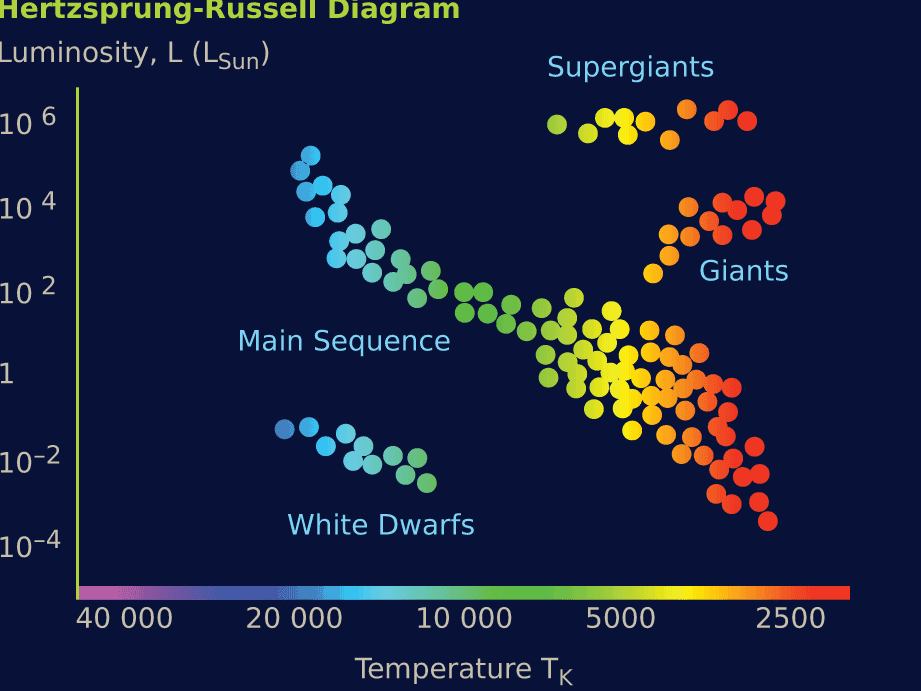Stars are fundamental objects in the observable universe. The cosmic realm is vast and varied. The subject of celestial luminaries is inexhaustible. The sun was designed to radiate light during the day, while stars were created to guide humanity’s way in the darkness of the night. In this article, we will explore the process behind the formation of the light that emanates from these awe-inspiring celestial bodies.
Origin
The creation of a star, as well as its demise, can be witnessed in the night sky. Scientists have long been observing these occurrences and have already made numerous breakthroughs. All of these findings are documented in specialized scientific literature. Stars are radiant spheres of immense proportions. However, what causes them to emit light, twinkle, and radiate in various hues?
These celestial entities are formed from a diffuse mixture of gas and dust that undergoes gravitational compression in denser layers, along with the influence of their own gravity. The interstellar medium is primarily composed of gas (hydrogen and helium) along with a dust made up of solid mineral particles. Our primary source of light is a star known as the Sun. Life on our planet would be impossible without it. Interestingly, many stars are significantly larger than the Sun. So why don’t we feel their gravitational pull and continue to exist undisturbed?
Our primary source of heat and light is situated in close proximity to the Earth. As a result, it is imperative for us to perceive its radiant light and warmth. Although stars are hotter and larger than the Sun, they are positioned at such vast distances that we can only observe their luminous glow, and even then, solely during the night.
During the night, stars appear as mere twinkling dots in the expansive sky. However, it is puzzling why we are unable to see them during the day. The phenomenon can be likened to the rays emitted from a flashlight, which are barely visible in the daylight, yet indispensable at night, as they effectively illuminate our path.
What causes stars to shine the brightest and when is the optimal time for stargazing?
The month of August offers the ideal conditions for stargazing, with its dark evenings and clear air. It creates a sense of closeness to the sky, as if one can almost touch it. Whenever they gaze upwards, children are always fascinated by the question: “Why do stars shine and where do they go?” The phenomenon of stargazing is particularly common in August, captivating our eyes and souls with its extraordinary beauty. It is believed that if one sees a shooting star during this time, making a wish upon it guarantees its fulfillment.
However, it is fascinating to note that what appears to be a falling star is actually a meteor ablaze. Nevertheless, this spectacle remains incredibly breathtaking! As time passes, generations come and go, yet the sky remains constant – enchanting and enigmatic. Just like us, our predecessors gazed upon it, envisioning mythological figures and objects within the constellations, making wishes and indulging in dreams.
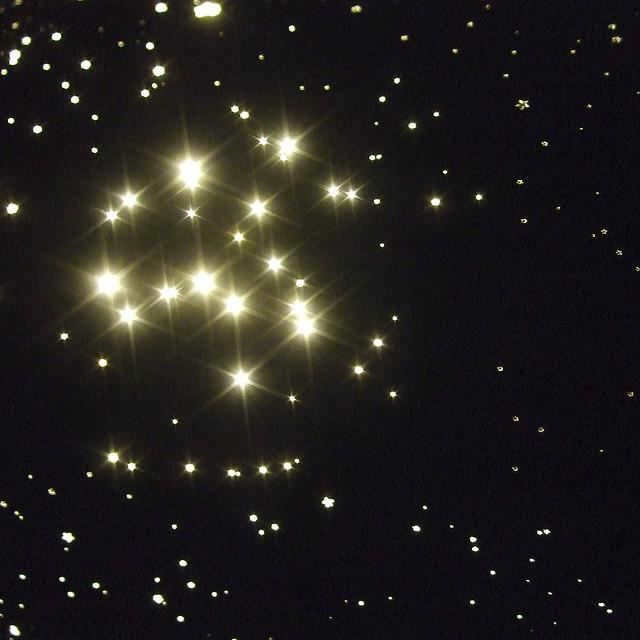
What causes the appearance of light?
Stars, which are cosmic entities, emit a vast amount of heat energy. As a result, they also emit a significant amount of light, some of which reaches our planet, giving us the ability to observe it. This is the basic explanation for why stars illuminate the night sky and whether all celestial bodies share this characteristic. Take the Moon, for instance, which is Earth’s satellite, or Venus, a planet within our solar system. We do not see these celestial bodies emitting their own light; rather, we witness the reflection of light. Stars, on the other hand, are independent sources of light radiation produced by the release of energy.
Various celestial objects emit light in different colors, with some appearing white, blue, or orange, while others exhibit a shimmering array of hues. The reason for these variations in color can be attributed to the composition and temperature of these objects. Stars, for instance, are massive spheres composed mostly of gases that are heated to incredibly high temperatures. It is this fluctuation in temperature that accounts for the diverse range of colors observed in stars. The hottest stars emit a brilliant blue light, followed by white stars, then cooler yellow stars, and finally stars that emit an orange or red hue.
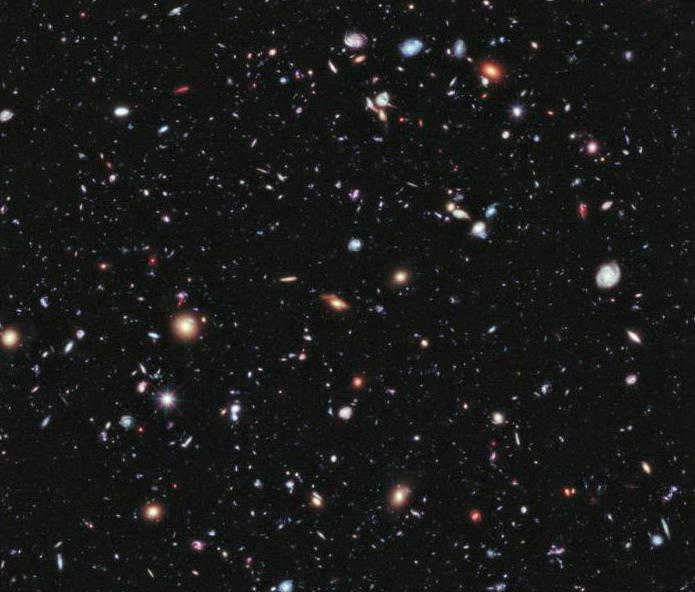
The Phenomenon of Twinkling Stars
Curiosity arises in the minds of many individuals: why do stars emit light during the night and exhibit a flickering effect? Initially, let it be known that stars do not actually twinkle. It is merely an optical illusion perceived by us. The reason behind this phenomenon lies in the journey of starlight through the Earth’s atmosphere. As the light beam traverses such colossal distances, it experiences numerous refractions and alterations. To us, these alterations manifest as the twinkling effect.

A star goes through different stages in its life cycle, each stage causing it to emit light in a unique way. As the star nears the end of its life, it gradually transforms into a red dwarf and cools down. The dying star emits pulsating radiation, giving the appearance of flickering or blinking. During the day, the light from the star is not visible because it is overpowered by the bright sunlight. This is why we can only see stars at night, when there are no rays from the Sun.
Stars are classified into spectral classes based on their electromagnetic radiation spectrum. This classification provides important information about the star’s temperature, pressure of its upper layers, chemical composition, and other physical characteristics.
In a straightforward scenario, the spectrum can be acquired in the following manner: The light emanating from an object is transmitted through a slender aperture that has a prism positioned behind it. The prism refracts the light, which is subsequently projected onto either a screen or a specialized photographic film. The resultant image manifests as a seamless progression of hues, ranging from violet to red. A spectrum that lacks any dark lines is referred to as a continuous spectrum. A comparable depiction is witnessed when light is emitted by either solid or liquid entities, such as an incandescent lamp.
Let’s examine this scenario: imagine having a burner with a quantity of salt placed in its flame. In this particular situation, we will observe a vibrant yellow hue in the flame’s illumination. Moreover, when we observe the vapors, we will notice a distinct yellow streak. This signifies that the sodium vapor, once heated, emits light with a wavelength in the yellow spectrum. This characteristic is present in all substances in their gaseous form, and its spectrum is referred to as line-shaped.
During his observation of the Sun, the German optician Joseph Fraunhofer made an interesting discovery – he noticed the presence of thin black lines in the Sun’s continuous emission spectrum. Subsequently, Gustav Kirchhoff established that when a gas is in a state of luminescence, it absorbs light rays of the same wavelengths that it emits itself. These black lines, which appeared in the continuous spectrum, were named absorption lines. By utilizing these principles, scientists were able to determine the chemical composition of stars. This was made possible because the gases in the atmosphere absorbed radiation at specific wavelengths.
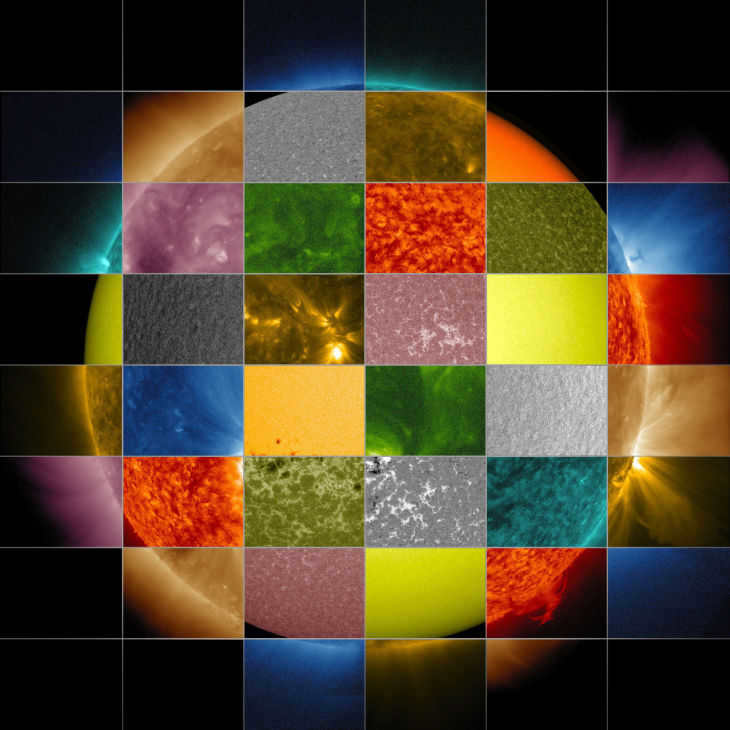
Later in the field of spectroscopy, numerous methods emerged for examining different characteristics of stars, such as shifting the spectrum to a specific side, comparing it with the spectrum of a fully black body, and observing the bifurcation of superimposed lines, among others.
Stars do not reflect light like planets and their moons, but instead emit light. Moreover, they do so consistently and evenly. The twinkling effect that we observe from Earth is likely caused by the presence of various microparticles in space that interrupt the light beam when they pass through it.
The most brilliant celestial body, as perceived by inhabitants of planet Earth
As we learn from our educational years, the Sun is categorized as a star. However, in terms of size and luminosity, it is considered to be slightly below average in the grand scale of the Universe. While there exists a multitude of stars that surpass the Sun in size, they are significantly dimmer in comparison.
Stellar gradation
The classification of celestial luminaries based on their brightness has been a practice that dates back to ancient Greek astronomers. The term “magnitude” refers to the luminosity of a star, rather than its physical size, both in the past and present.
Additionally, stars exhibit variations in their radiation wavelengths. Astronomers are able to determine the chemical composition, temperature, and distance of a celestial body by analyzing its diverse wavelength spectrum.
Scientists debate
The question of “why stars shine” has been the subject of debate for decades. There is still no consensus among scientists. Even nuclear physicists find it hard to believe that the reactions occurring within a star can release such an enormous amount of energy without ever stopping.
The mystery of what is happening inside stars has long fascinated astronomers, physicists, and chemists. They have all attempted to determine what drives the eruption of thermal energy that is accompanied by bright radiation.
Chemists propose that the light emitted by distant stars is the result of an exothermic reaction that produces a significant amount of heat. Physicists, on the other hand, argue that there can be no chemical reactions taking place within a star. They believe that none of these reactions could continue uninterrupted for billions of years.

The discovery of the periodic table of elements by Mendeleev brought us closer to understanding why stars shine. It revolutionized our understanding of chemical reactions and shed new light on the process. Through experiments, scientists were able to obtain new radioactive elements, leading to the prominence of the theory of radioactive decay in the ongoing debate about the source of starlight.
The contemporary theory
Svante Arrhenius, a Swedish scientist, was deeply intrigued by the radiating light of a distant star. In the early 20th century, he revolutionized the concept of stellar heat radiation by developing a groundbreaking hypothesis. According to his theory, the primary source of energy within a star’s core is hydrogen atoms. These atoms undergo continuous chemical reactions, eventually transforming into helium, a much denser element. These transformation processes are facilitated by the immense pressure and mind-boggling temperatures (15,000,000̊C) present within the star’s gaseous environment.
Many scientists have been intrigued by the hypothesis. The unambiguous result was that the stars in the night sky emit light due to ongoing fusion reactions, which release a tremendous amount of energy. It also became evident that hydrogen fusion has the potential to continue indefinitely for billions of years.
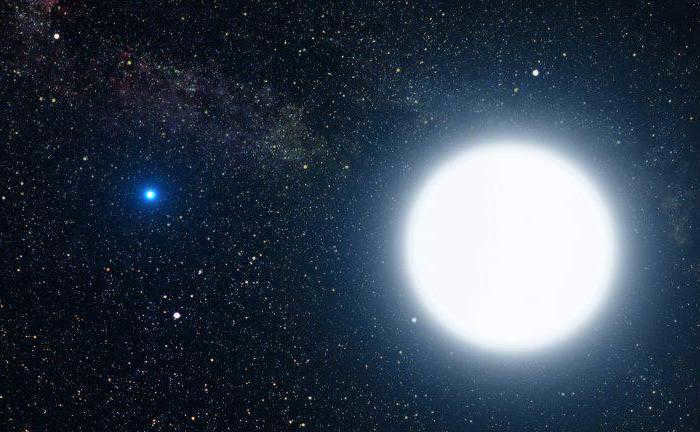
Therefore, what is the reason behind stars shining? The energy that is released within their core is transferred to the outer gas shell, resulting in the emission of visible radiation. Presently, scientists are highly confident that the path taken by this radiation from the core to the shell spans over a duration of more than one hundred thousand years. Similarly, the journey of this radiation from a star to the Earth is also quite extensive. While it takes only eight minutes for the Sun’s radiation to reach our planet, a brighter star like Proxima Centauri’s light can take almost five years, while the light from other stars can travel for tens and even hundreds of years.
Yet another “why?”
The reason behind the emission of light by stars has been clarified. However, why do stars flicker? Contrary to the perception, the light emitted by a star is actually steady. This steadiness is disrupted by the gravitational force, which pulls back the gas pushed out by the star. The flickering of a star is an optical illusion. When we observe a star, our eyes perceive it through multiple layers of constantly moving air. As the star’s light passes through these layers, it appears to flicker.
Due to the continuous motion of the atmosphere, streams of hot and cold air interact and create swirls. These swirls cause the star’s light beam to bend and fluctuate. Furthermore, the concentration of the light beam that reaches us is uneven, leading to changes in the star’s apparent pattern. This phenomenon can be attributed to various atmospheric disturbances, such as gusts of wind.
Multicolored celestial bodies
On clear nights, the celestial expanse delights observers with its vibrant array of colors. The rich orange hue of Arcturus contrasts with the delicate red shades of Antares and Betelgeuse. Sirius and Vega exhibit a milky-white tone, while Regulus and Spica possess a subtle blue tint. The renowned giants, Alpha Centauri and Capella, radiate a beautiful golden hue.
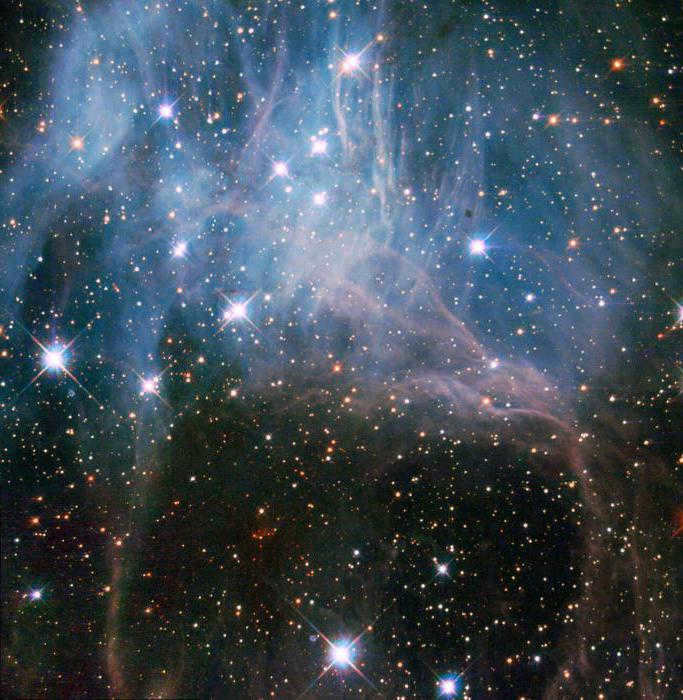
What causes stars to emit light in different ways? The color of a star is determined by its internal temperature. The coolest stars are red, with a surface temperature of only 4,000°C. Meanwhile, the hottest stars can reach surface temperatures of up to 30,000°C.
Astronauts have revealed that stars actually shine uniformly and brightly, but they appear to twinkle from our perspective on Earth.
In ancient times, people believed that stars were either the souls of humans or nails that held up the sky. They came up with various explanations for why stars emit light at night, and for a long time, the Sun was believed to be a completely separate entity from the stars.
The issue of thermal reactions happening in stars in general and specifically in the Sun – the nearest star to us – has long been a concern for scientists across various scientific fields. Physicists, chemists, and astronomers have all attempted to comprehend the factors that result in the release of thermal energy accompanied by intense radiation.
Chemists have held the belief that exothermic chemical reactions take place in stars, leading to the release of significant amounts of heat. However, physicists have disagreed, as they couldn’t fathom how reactions between substances in these celestial objects could generate such immense light over billions of years.
With the advent of Mendeleev’s renowned table, a new era in the study of chemical reactions emerged, as radioactive elements were discovered. It soon became apparent that radioactive decay reactions were the primary cause of stellar emissions.
The contemporary concept of stellar radiation
In 1903, the long-standing understanding of the reasons behind the luminosity and thermal emission of stars was revolutionized by the Swedish scientist Svante Arrhenius, who proposed the theory of electrolytic dissociation. As per his hypothesis, the primary energy source in stars is the fusion of hydrogen atoms, resulting in the formation of heavier helium nuclei. These fusion reactions occur in the star’s inner regions, where there is intense gas pressure, high density, and temperatures reaching around fifteen million degrees Celsius. Upon further investigation by other researchers, it was determined that such fusion reactions can release an immense amount of energy, explaining the stellar radiance. Moreover, it is believed that hydrogen fusion enables stars to emit light for billions of years.
The energy generated within stars is transmitted to the outer regions of gas and eventually to the star’s surface, where it is emitted as light. It is believed by scientists that the journey of light rays from the core of a star to its surface can take tens or even hundreds of thousands of years. Once the light reaches the surface, it then travels through space for an additional amount of time before reaching the Earth. As a result, it takes approximately eight minutes for the Sun’s radiation to reach our planet, while the light from Proxima Centauri, the second closest star to us, takes over four years to reach us. The light from many stars that are visible to the naked eye has traveled for thousands or even millions of years before reaching our eyes.
Also, check out these related articles:
Categories
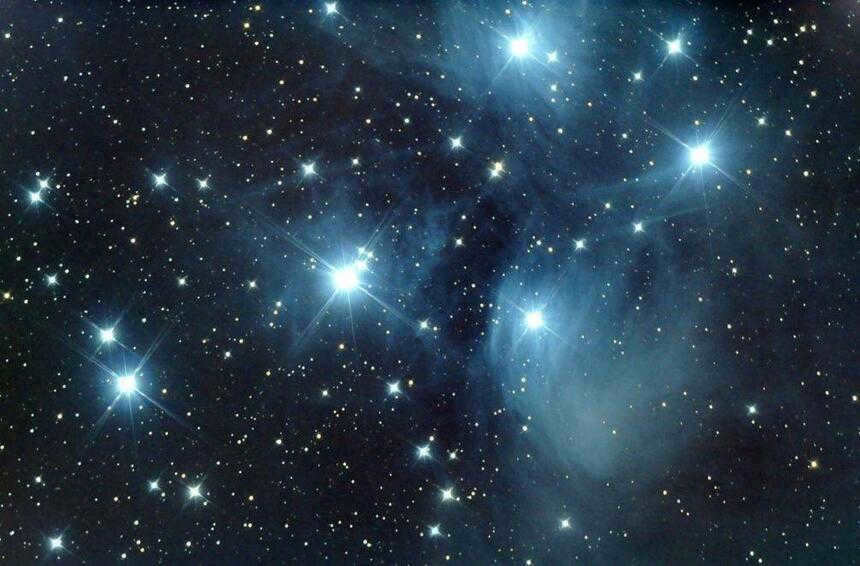
When observing the sky, it becomes evident that the stars emit a diverse array of colors. Even with the naked eye, one can perceive the shimmering hues. However, when observing them through a telescope, the true breadth of colors becomes even more apparent.
Moreover, numerous stars exhibit the ability to change these colors with varying frequency and intensity. For instance, the blue-colored Sirius has been known to suddenly display shades of pale green and deep blue.
Factors influencing the color of a star
A star is a celestial object consisting of glowing plasma or gas. Over an extended period, its physical characteristics remain constant. One critical factor that determines the color of a star is its temperature.

Therefore, the hottest stars possess a blue hue, while those that are less hot exhibit a green color. In the case that a star is slightly warm, resembling the Sun, it will assume a yellow shade. Finally, the coldest stars are characterized by a red appearance.
Explaining the Phenomenon of Star Twinkling
In actuality, the twinkling effect is merely an illusion perceived by us. The light emitted by stars undergoes refraction as it passes through Earth’s atmosphere. The atmosphere causes the color of the rays to become more or less saturated. When a star is situated close to the horizon in relation to the observer, its twinkling effect is at its maximum.
If one were to observe the stars from an airplane’s porthole, the twinkling effect would be imperceptible, and in space, it is non-existent.
Read also:
When gazing into the vast expanse of the night sky, one can witness the mesmerizing spectacle of celestial bodies shimmering and pulsating with a myriad of colors. Some stars appear to flicker and fade, others appear to quiver, while some even exhibit fluctuations in their luminosity. Scientists have provided scientific explanations for the phenomenon of star twinkling, as well as why it becomes particularly pronounced on chilly or windy nights. It is as if the universe possesses the power to transport an individual into an indescribable trance.
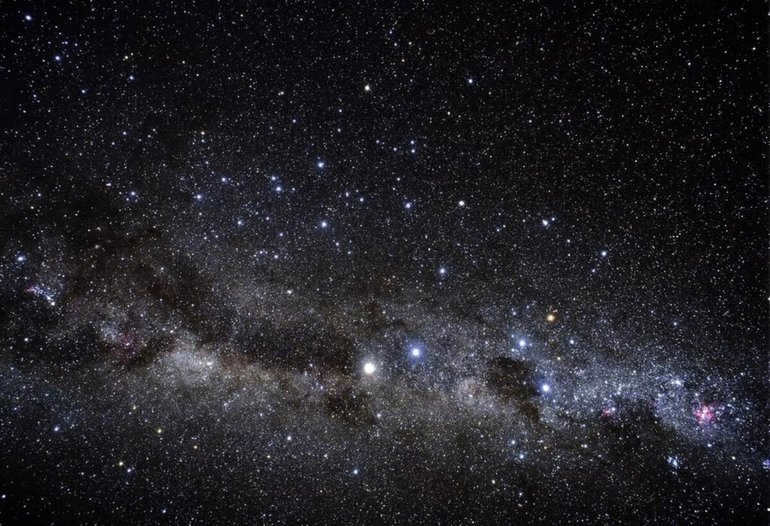
Reasons behind the luminosity of celestial bodies
The celestial bodies that we can observe with the naked eye at night, such as stars, are massive objects. Although they may appear as tiny dots from Earth, their brightness is so intense that it can travel vast distances to reach the planet’s surface.
Stars are primarily irregularly shaped spheres composed of gas, often with jagged edges. Deep within them, there is a continuous process of thermonuclear fusion. This ongoing process causes the gas within the stars to heat up, resulting in the emission of light. In reality, the radiation emitted by stars is a relatively steady and uninterrupted stream. The phenomenon of twinkling, however, can only be observed from the Earth’s surface.
As they journey through the atmosphere, the rays conquer a vast expanse, a barrier separating space from the planet. This expanse is marked by a diverse composition, with each layer possessing distinct temperatures and density measures, leading to the phenomenon of light being refracted multiple times. It is through these physical processes that individuals are able to witness the captivating visual spectacle known as star twinkling.
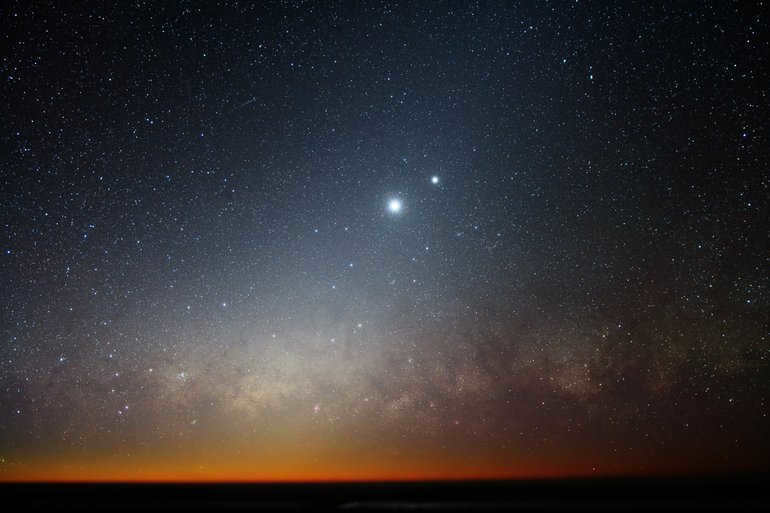
However, if you observe celestial objects from a different perspective, such as from the surface of the Moon, other planets, or from a spaceship, you will notice that the stars do not flicker. This is because there is no atmosphere present, causing the luminosity of cosmic objects to be continuous and uniform.
The atmosphere is not only heterogeneous in terms of density, but it is also constantly in motion:
The movement of the atmospheric composition leads to the scattering and decomposition of light into spectra, while also refracting them. Physicists explain this phenomenon as the result of looking at the stars through a large prism.
The most vibrant and vibrant celestial bodies are those that are not too high above the horizon. Sirius is the most brilliant star that catches the eye at almost any time of the year. And according to popular beliefs, a strong flicker in the summer indicates an approaching abrupt change in weather due to a powerful cyclone.
The exceptionally beautiful glow hinders astronomers from conducting astronomical observations, but it is this phenomenon that gives the sky such a close and vibrant appearance.
Temperature’s Impact on Flicker Shade
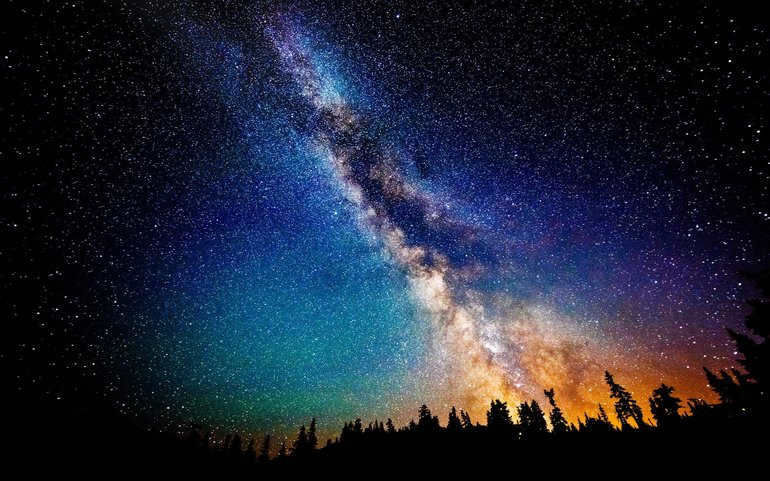
First and foremost, it’s important to note that each star has its own unique color. This characteristic is determined by the star’s temperature and the intensity of the thermonuclear reaction occurring within it. The higher the temperature, the closer the star’s color will be to a bluish or white hue. These stars are the hottest, even surpassing the surface temperature of the sun. In contrast, yellow and red stars are cooler.
You can observe the change in color as a material heats up by looking at the example of a metal surface. As the temperature increases, the original color of the material changes from a bright red to a brilliant white at its highest temperature. Astronomers can estimate the age of celestial bodies based on the light they emit.
- During the moment of explosion, a star exhibits its highest temperature and emits a brilliant blue-white light;
- As the intensity of the reactions diminishes, the color of the star shifts towards a yellowish hue;
- At the end of its life cycle, the star transitions to a red color.
Therefore, the Sun, which radiates a vibrant orange glow, can be classified as being in its “middle-age category” today. It is this concept that scientists use to explain the phenomenon of stars twinkling in various colors.
Distinct Characteristics of Planetary Radiation
It is important to acknowledge that not all celestial entities visible in the nocturnal firmament possess the capacity to radiate enigmatically and twinkle. Planets do not emit luminosity; they can be discerned by their appearance even from a distance: rather than appearing as mere specks, they manifest as glowing disks with well-defined, uniform perimeters. These are stars that extinguished countless millennia ago and no longer contain any gaseous matter.

The planets themselves do not emit light, but rather serve as surfaces that reflect the rays from a nearby celestial object. In our solar system, this would be the Sun.
Another way to differentiate planets with the naked eye is by observing their movement against the backdrop of the night sky. Jupiter and Venus can be easily seen from Earth with their yellowish glow, and sometimes Mars appears with its distinct red disk. However, other dim space giants can only be observed with the help of astronomical instruments.
Thankfully, it is possible to appreciate the magnificence of the celestial sphere, comprehending the reason behind the intermittent twinkling of stars, and discerning them from the celestial bodies known as planets, even in the absence of any specialized apparatus. A clear and unobstructed nocturnal firmament, untainted by the luminous glow of urban settlements, is a truly awe-inspiring spectacle that never fails to captivate and enchant, evoking a sense of tranquility and inspiring boundless imagination.
The phenomenon of a star’s birth and demise is observable in the nocturnal heavens. For an extended period, astronomers have been closely monitoring these occurrences and have amassed a multitude of findings. All of these breakthroughs have been meticulously documented in specialized scientific publications. Stars are radiant celestial bodies of immense proportions. However, the reason behind their luminosity, flickering, and iridescent hues remains a subject of inquiry.
These celestial entities are formed from a diffuse gas-dust medium that occurs due to gravitational compression in denser layers, combined with the influence of their own gravity. The interstellar medium mainly consists of gas (hydrogen and helium) along with solid mineral particles in the form of dust. Our primary celestial body is a star known as the Sun. Life on our planet would be impossible without it. Interestingly, there are many stars that are much larger than the Sun. So why don’t we feel their impact and continue to exist without them?
The source of our heat and light is located in close proximity to the Earth. Therefore, it is crucial for us to directly experience its light and warmth. Stars may be hotter and larger than the Sun, but they are situated at such great distances from us that we can only observe their light, and that too only during nighttime.
At night, they appear as mere twinkling points in the sky, but why are they invisible during daylight hours? Starlight is akin to the beams of a flashlight, barely discernible amidst the brightness of the sun. Yet, come nighttime, it becomes indispensable, casting its luminosity upon the path ahead.

What sets stars apart from planets
The distinction lies in their radiation: stars emit light, while planets do not. However, during significant disturbances in the Earth’s atmosphere, such as storms, planets can also appear to flicker.
The Sun, too, is a star that is closer to the Earth’s surface than the stars visible at night. Unlike the stars, the Sun is not a mere dot in the sky. It appears to humans as a massive, uniformly glowing disk. If this celestial body were to be moved to an immense distance from the Earth, it would blend in with the other stars and twinkle just like them.
What is the optimal month for observing the brightest stars in the night sky and what causes them to emit light?
The month of August provides the perfect conditions for stargazing enthusiasts. During this time, the nights are exceptionally dark and the atmosphere is free from any obstructions, allowing for an unobstructed view of the celestial bodies. It almost feels as if one can touch the sky. When children gaze up at the night sky, they often find themselves pondering the source of the stars’ luminosity and their eventual descent. In reality, August is a popular time for stargazing, and this captivating spectacle captivates both our eyes and our spirits. It is commonly believed that if one catches sight of a shooting star, they should make a wish, as it is said to have the power to come true.
Interestingly, it is not a star that falls, but rather a burning meteor. Nevertheless, the beauty of this event remains unchanged! As time passes and generations come and go, the sky remains as captivating and enigmatic as ever. Just like our ancestors, we gaze at the sky, envisioning mythological figures and objects within the constellations, making wishes, and dreaming.
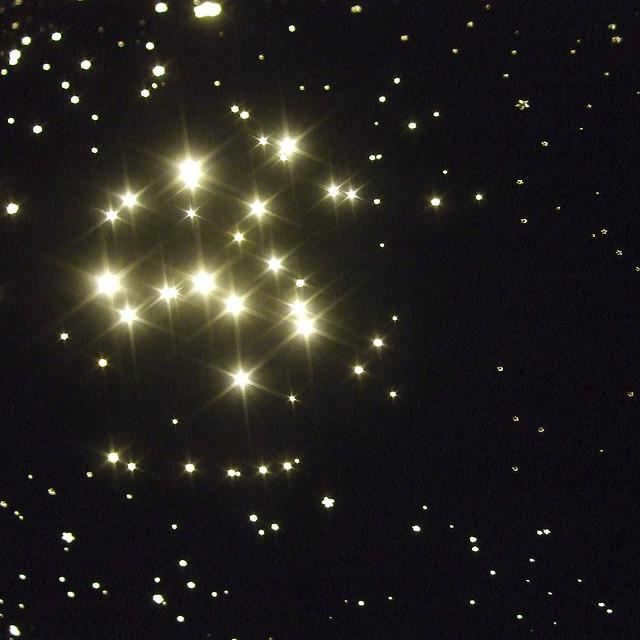
What is the reason behind the absence of green stars?
Step outside during a dark, moonless night. Look up. If it happens to be December or January, take note of the red-hot Betelgeuse on Orion’s shoulder and the dazzling blue star Rigel at its knee. A month later, you’ll witness the appearance of yellow Capella in the constellation of Ascendant.
If it’s July, direct your gaze towards Vega, the sapphire-like blue star in Lyra, or Antares, the fiery orange-red heart of Scorpio.
Strangely enough, there are no green stars! No matter the time of year, the night sky offers a myriad of stars. Most of them appear white, but the brightest ones display various colors. Red, orange, yellow, blue – almost every color of the rainbow… But hold on a second, where are the green ones? Shouldn’t we be able to see those as well?
No, we don’t observe any green stars, which is a frequently asked question. Let me explain why. Imagine taking a blowtorch (you can do it mentally) and heating up a bar of iron. Initially, it will start glowing red, then transition to orange, and eventually become blue-white before eventually melting. Alternatively, you could use a tack for a similar effect.
Now, why does it glow? Well, any substance that is above absolute zero (approximately -273 °C) will emit light. The amount and wavelength of the light depend on the temperature of the object. The hotter the object, the shorter the wavelength of the emitted light.
Cold objects emit radio waves, while very hot objects emit ultraviolet or X-rays. However, within a specific temperature range, hot objects will emit visible light, which falls within the wavelength range of approximately 300 nm to 700 nm.
It is important to note that objects do not emit light at a single wavelength. Instead, they release photons across a range of wavelengths. If one were to utilize a detector that is sensitive to the emitted wavelengths of light from an object and then graph the number of those wavelengths, a curved graph known as the “blackbody radiation characteristic” would be obtained (the reason for this name is not significant, but if you are curious, you can conduct a search. Just activate the search engine filter. Seriously). This graph somewhat resembles the bell curve of a normal distribution, but it declines more rapidly at shorter wavelengths and more slowly at longer wavelengths.
Below are several examples of curves for various temperatures:
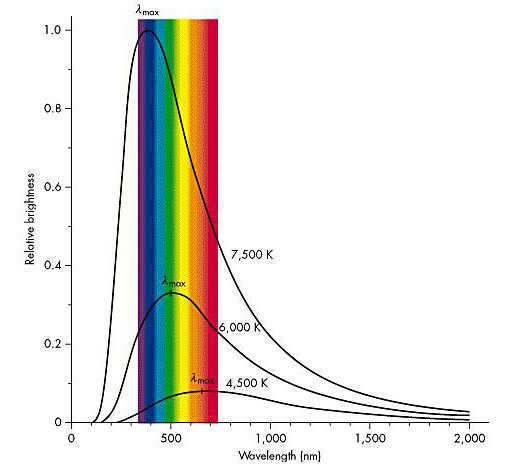
The x-axis represents the wavelength, or color, and the graph includes the spectrum of visible colors as a reference. The graph displays a distinct bell-shaped curve. In the case of hot objects, the peak of the curve shifts to the left, indicating shorter wavelengths.
For an object with a temperature of 4500 Kelvin (approximately 4200 °C), the peak appears in the orange section of the spectrum. As the temperature increases to 6000 K (around the temperature of the Sun, 5700 °C), the peak moves towards the green-blue region. With further heating, the peak shifts towards the blue region, and in some cases, even beyond, to shorter wavelengths. The most intense emission of light from the hottest stars occurs in the ultraviolet range, which consists of shorter wavelengths than those visible to the naked eye.
Hold on for a moment. If the Sun has a peak in the green-blue region, why doesn’t it appear green-blue? That’s the main question. The fundamental point is that despite the peak being in the green-blue region, it also emits light of other hues.
Examine a graph of an object with a temperature similar to that of the sun. It peaks in the green-blue region, meaning most photons are emitted there. However, both blue and red photons are also emitted. When we observe the Sun, we perceive all these colors simultaneously. Our eyes blend them and produce a single color: white. Yes, white. Some individuals claim that the Sun is yellow, but if it were truly yellow, then the clouds and snow would also be yellow (not just the snow in your yard where the dog walks).
That is the reason why the Sun does not appear green. However, is it possible to manipulate the temperature to create a green star? Perhaps one that is slightly hotter or cooler than the Sun?
Unfortunately, it is not possible. A hotter star emits more blue light, while a cooler star emits more red light, and in either case, our eyes will not perceive the color green. The responsibility for this limitation should not be solely placed on the stars, but on ourselves.
Our eyes contain light-sensitive cells called cones and rods. Rods are responsible for detecting brightness and do not differentiate between colors. Cones, on the other hand, are responsible for perceiving colors and there are three types of cones: red-sensitive cones, blue-sensitive cones, and green-sensitive cones. When light of a certain color reaches our eyes, each type of cone reacts differently: red-sensitive cones respond to red light, while blue and green-sensitive cones do not react to it.
Most objects don’t emit or reflect a single color, so the cones are stimulated all at once, but to varying degrees. For instance, an orange stimulates the red cones twice as much as the green cones, while leaving the blue cones unaffected. When the brain receives a signal from three cones, it determines, “It must be an orange object.” If the green cones receive the same amount of light as the red cones, and the blue cones receive no light, we perceive the color as yellow. And so on.
Therefore, the only way for a star to appear green is if it emits only green light. However, as shown in the graph above, this is impossible. Any star emitting green light will also emit a significant amount of red and blue light, which will make it appear white. Changing the temperature of a star will cause it to appear orange, yellow, red, or blue, but it cannot appear green. Our eyes simply do not perceive it in that way.
That is the reason why a green star does not exist. The emission of colors by stars and the way our eyes perceive them ensures this.
However, this does not concern me. If you observe through a telescope and witness the radiant Vega, the reddish Antares, or the deep orange Arcturus, you will not be bothered either. Stars may not manifest in every color imaginable, but there is an abundance of them, and as a result, they possess an astonishing beauty.
How is light generated?
Stars, which are cosmic objects, emit immense amounts of heat energy. This energy release is accompanied by a strong emission of light, some of which reaches our planet, allowing us to observe it. This answers the question of why stars shine in the sky and whether all celestial bodies emit light. Take the Moon, for instance, which is Earth’s satellite, or Venus, a planet in our solar system. We don’t see their own light, but only the reflection of light. Stars, on the other hand, are the actual source of light radiation as a result of energy release.
Various celestial entities emit light in different colors. Some emit white light, while others emit blue or orange light. There are even some that shimmer with a variety of hues. The reason for this variation in color is the composition and temperature of these celestial bodies. Stars, for example, are massive spheres composed of gases that are heated to extremely high temperatures. The temperature of a star affects its luminosity, resulting in different colors. The hottest stars emit blue light, followed by white. Cooler stars emit yellow, orange, and finally red light.
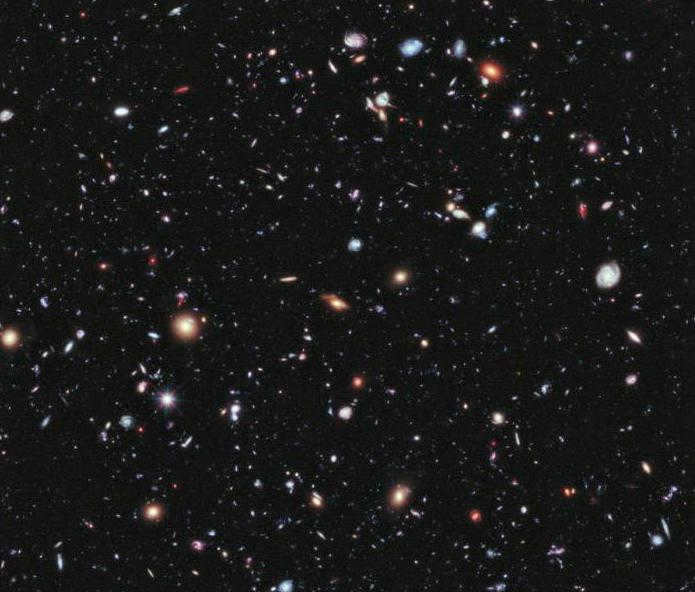
The Phenomenon of Starlight
Many individuals often ponder the reason behind the illuminating glow of stars during the night, as well as the fluctuation in their luminosity. Firstly, it is important to note that stars do not truly twinkle, although it may appear that way to the human eye. In reality, starlight traverses the vast expanse of Earth’s atmosphere. As it journeys through such great distances, the light encounters numerous refractions and alterations. These refractions manifest to us as the perception of twinkling.

Also, take a look at: Polaris. In which constellation is it located? Stars ContentsNameOverall characterizationThe precise distance to EarthThe structure of the Polaris star systemDescriptionThe life of a supergiantIntermittent starParticularities
A star has its own life cycle. It glows differently at various stages of this cycle. When it reaches the end of its existence, it gradually transforms into a red dwarf and cools down. The radiation of a dying star pulsates. This creates the illusion of flickering or blinking. During the day, the star’s light doesn’t disappear; it is simply overshadowed by the bright and close sunlight. That’s why we can see stars at night, as there are no rays from the Sun.
Starlight and the Earth’s Atmosphere
The twinkling of stars that is visible to the human eye is not a characteristic of the stars themselves, but rather a phenomenon caused by the way our eyes perceive them from Earth. Have you ever noticed how stars twinkle more brightly on frosty nights or immediately after rainfall?
The reason behind this twinkling is the Earth’s atmosphere. Stars emit light, which then travels through the layers of our planet’s atmosphere. However, the atmosphere is not consistent throughout.
As the starlight travels through different areas of the atmosphere with varying densities and temperatures, it undergoes refraction. The sections of the atmosphere with different densities cause the light rays to refract in different directions.
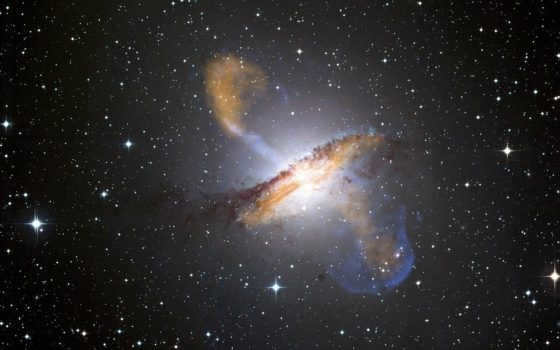

We must not forget that air masses are in constant motion: warm air rises, while cold air descends towards the Earth’s surface. The refraction of light in the atmosphere depends on the temperature of the air. As starlight passes through regions of the atmosphere with varying densities, it undergoes flickering. The brightness of the stars also fluctuates, fading and then shining brightly once again.
This phenomenon is known as scintillation, and it is influenced by turbulent vortices that move in different directions at different altitudes.

